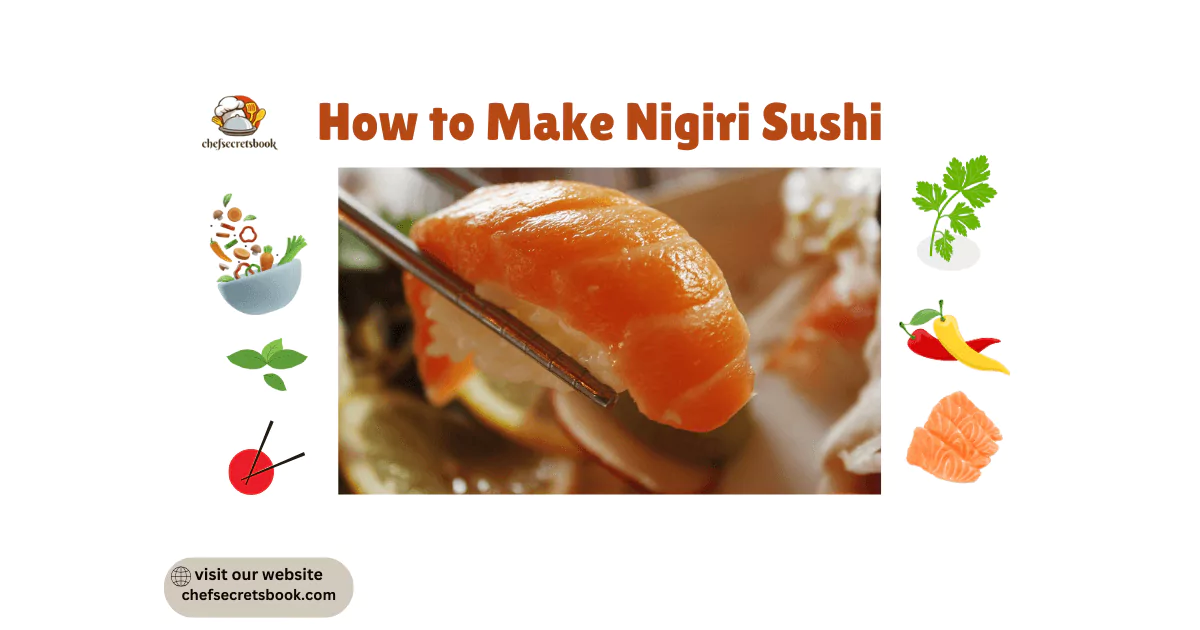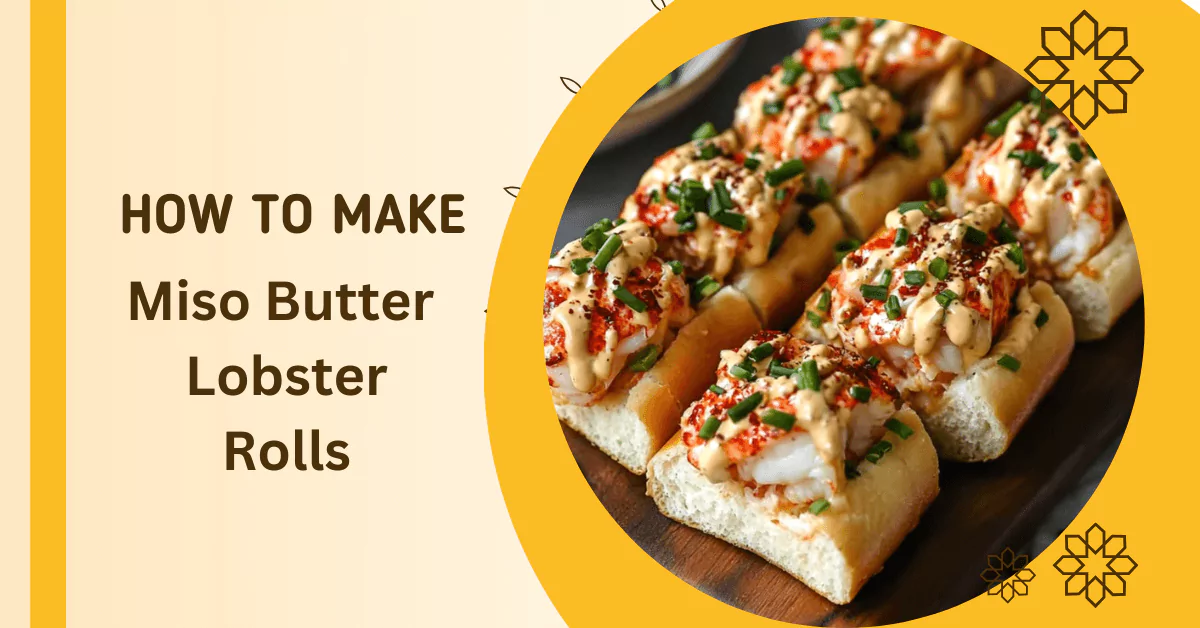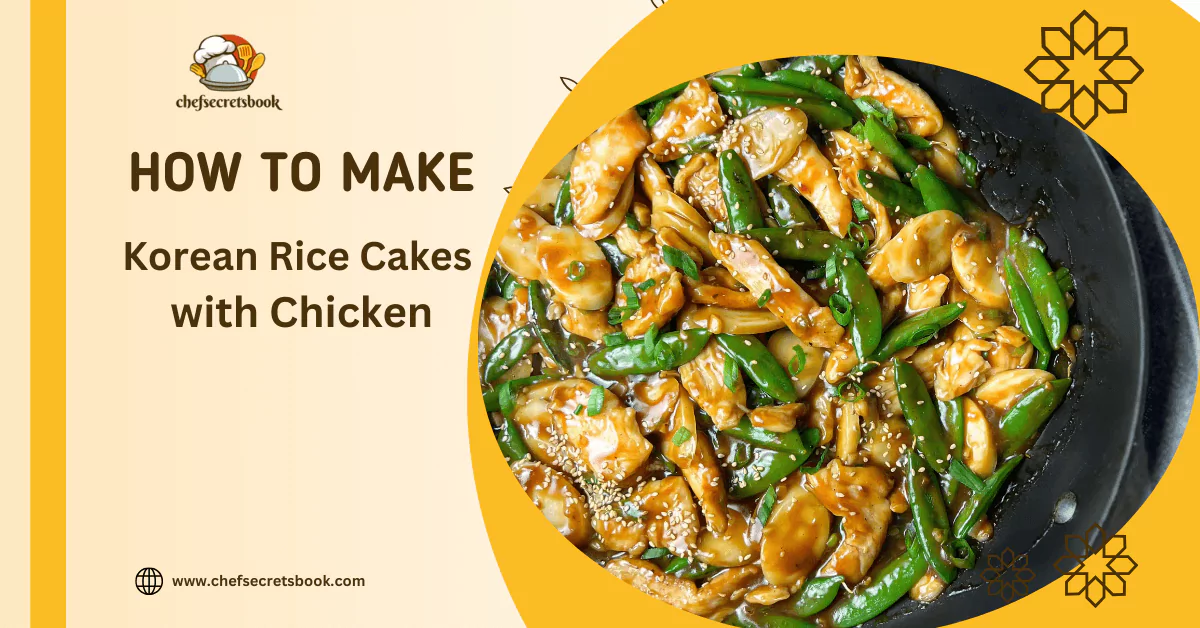Mastering the way to make Nigiri Sushi at domestic opens up an international of actual Japanese flavors in your kitchen. This easy Nigiri Sushi recipe is ideal for beginners and sushi fanatics alike, guiding you with the useful resource step through the vital strategies of sushi rice training, fish choice, and shaping. With the right components and a piece of exercise, you’ll soon be developing scrumptious, eating place-excellent Nigiri Sushi from scratch.
Nigiri Sushi is a conventional Japanese delicacy made with easy fish and pro rice, forming an ideal stability of taste and texture. This manual covers everything from choosing the suitable sushi rice and fish to guidelines for growing the appropriate rice-to-fish ratio. Whether you’re making salmon Nigiri, tuna Nigiri, or venturing into specific famous toppings, each piece of Nigiri will show off the freshness and purity of your factors.
Homemade Nigiri Sushi isn’t only a nice price-powerful but additionally, a unique manner to experience Japanese cuisine properly at home. With this recipe, you can find diverse kinds of Nigiri toppings, inclusive of seared alternatives like Aburi Nigiri for brought flavor. Learning the ones conventional strategies will make you revel in like a sushi chef as you create this beautiful, handmade dish to proportion and enjoy.

What is Nigiri Sushi?
Nigiri Sushi, or without a doubt Nigiri, is one of the most loved forms of Japanese sushi, recognized for its simplicity and cognizance of smooth, remarkable elements. Unlike sushi rolls, which include seaweed and various fillings, Nigiri capabilities as a small mound of vinegared rice, hand-original, and crowned with a thin slice of raw fish or other seafood. Traditionally served with a slight brushing of soy or Nikiri sauce, Nigiri Sushi we ought to the herbal flavors of the fish and rice shine, making it a favorite for sushi purists.
Each piece of Nigiri Sushi is cautiously crafted to show off the texture, flavor, and excellence of each rice and fish. Toppings can range widely, from popular selections like salmon and tuna to eel, shrimp, or even seared options, developing a versatile dish that may be custom-designed to flavor. For many, Nigiri captures the essence of Japanese sushi, embodying stability, elegance, and an appreciation for every aspect’s natural taste.
Nigiri vs. Sashimi: What’s the Difference?
Nigiri and Sashimi are two famous sorts of Japanese cuisine, each celebrating the freshness and first-rate uncooked fish, however, they vary in presentation and guidance. Nigiri Sushi consists of hand-pressed sushi rice topped with a slice of fish or seafood, sometimes brushed with a mild soy or Nikiri sauce. Each piece of Nigiri includes seasoned rice, making it a satisfying bite that combines the flavors of rice and fish.
Sashimi, however, is honestly thinly sliced, top-notch raw fish served without rice. It focuses simply on the natural taste and texture of the fish, frequently followed with the aid of garnishes like daikon radish, shiso leaves, and a dab of wasabi. While both highlight the freshness of seafood, Nigiri is technically a form of sushi (since it consists of rice), whereas Sashimi isn’t always, making it a purer presentation of uncooked fish enjoyed on its personal
Is Nigiri Hard to Make?
Nigiri can also moreover appear difficult before the entirety, however with the proper technique and a bit of practice, it’s pretty attainable even for beginners. Many expect making Nigiri is hard because of the precision in shaping the rice and decreasing the fish; however, the manner is more about getting to know easy, careful steps in place of complex capabilities. While sushi chefs train drastically about the quality of Nigiri, you can create scrumptious, visually appealing Nigiri at home the usage of that specialize in great substances, the proper rice texture, and some clean-to-comply strategies.
Is Nigiri Raw?
Yes, Nigiri is usually served with uncooked fish, such as salmon, tuna, or yellowtail, cautiously sliced and placed atop pro sushi rice. The use of raw fish allows Nigiri to be conscious of the freshness and herbal flavors of the seafood, which is why amazing, sushi-grade fish is essential. However, versions exist: some Nigiri can feature as seared or lightly grilled fish (referred to as Aburi Nigiri), cooked toppings like eel (unagi), shrimp (ebi), or even vegetarian options like tamago (Japanese omelet). These variations offer distinctive textures and flavors, catering to a number of tastes past uncooked fish.
What is the Sauce They Brush on Nigiri?
The sauce usually brushed on Nigiri is referred to as Nikiri sauce, a light, barely sweet soy-primarily based general glaze. Nikiri is made by simmering soy sauce with elements like mirin, sake, and a piece of sugar, resulting in a clean, flavorful sauce that enhances the herbal flavor of the fish without overpowering it. Traditionally, this sauce is lightly brushed onto the fish earlier than serving, giving Nigiri a subtle umami increase and a sleek finish.
In addition to Nikiri, some Nigiri variations may additionally feature other sauces, like ponzu for a citrusy note or yuzu kosho for a touch of spice. These sauces supplement precise styles of fish, adding a delicate layer of flavor while still letting the freshness of the seafood shine.
Ingredients for Nigiri
- Sushi Rice (Shari) – 1 cup of quick-grain or medium-grain rice, cooked and seasoned with rice vinegar, sugar, and salt. Cooked and pro with rice vinegar, sugar, and salt.
- Sushi-grade Fish – About 6 eight oz of clean, outstanding fish, like tuna, salmon, or yellowtail, thinly sliced.
- Seasoning for Rice – 2 tablespoons rice vinegar, 1 tablespoon sugar, half of teaspoon salt (regulate to flavor).
- Soy Sauce or Nikiri Sauce – Light soy-based sauce for brushing at the fish, enhancing flavor.
- Wasabi (elective) – A small dab for every piece, typically located between the rice and fish.
- Garnishes – Pickled ginger (gari) and extra wasabi for serving.
Special Notes on Ingredients
Sourcing Tips for Sushi-Grade Fish
- Look for Sushi-Grade Labels: Purchase fish labeled specially as “sushi-grade” or “sashimi-grade,” as this indicates it has been dealt with and frozen in keeping with FDA recommendations to reduce the hazard of parasites.
- Buy from Reputable Sources: Seek out areas of expertise in seafood markets, Japanese grocers, or online stores that specialize in sushi-grade fish. Some supermarkets also convey sushi-grade fish, but it’s nice to invite the fishmonger about its first-class and handling practices.
- Ask for Freshness Details: Inquire approximately when the fish become delivered and the way lengthy it’s been on show. Fresh, sushi-grade fish have to have an easy, moderate odor (no longer fishy) and a firm texture.
Recommendations for Freshness
- Consume Immediately: For a nice revel in, prepare and eat Nigiri quickly after making it to ensure maximum freshness.
- Store Properly: If getting ready earlier, keep the fish refrigerated till simply earlier than meeting, and cover the rice with a damp material to prevent it from drying out.
- Examine Quality: Fresh fish should be vibrant in color and moist. Avoid any pieces that appear dull, have a slimy texture, or emit a strong odor, as these are signs of declining freshness
Recommended Substitutes for Fish
- Cooked Shrimp (Ebi): A superb opportunity that requires no raw dealing, as pre-cooked shrimp can be used for Nigiri.
- Smoked Salmon: Offers a similar texture to raw salmon and provides a barely smoky flavor.
- Tamago (Japanese Omelet): A popular cooked topping with a sweet, savory flavor, perfect for those keeping off raw fish.
Step-by-Step Guide to Making Nigiri Sushi
Step 1: Prepare the Sushi Rice
- Rinse and Cook Sushi Rice: Begin via rinsing 1 cup of Japanese brief-grain rice in bloodless water till the water runs clean. Use a rice cooker or pot to cook dinner the rice, following instructions for sushi rice.
- Season the Rice: While the rice remains warm, lightly fold in a combination of 2 tablespoons rice vinegar, 1 tablespoon sugar, and 1 teaspoon salt to beautify taste.
- Cool the Rice: Transfer the seasoned rice to a wooden bowl (hangiri) and fan it to chill to room temperature. Proper cooling allows the rice maintain its form while forming Nigiri.
Step 2: Slice the Fish for Nigiri
- Choose Sushi-Grade Fish: Use fresh, sushi-grade salmon, tuna, yellowtail, or different favored seafood.d.
- Thinly Slice Fish: With a sharp knife, slice the fish into skinny, even portions about 2-three inches lengthy and ¼ inch thick. Cutting in opposition to the grain facilitates to hold a tender texture.
Step 3: Shape the Rice for Nigiri Sushi
- Wet Your Hands: Dip your arms in a bowl of water to prevent the rice from sticking.
- Form Rice Mounds: Take about 1-2 tablespoons of rice and lightly press it into a rectangular form the usage of your arms. Aim for a small, compact rice ball on the way to keep the fish securely with out being too tight.
Step 4: Assemble the Nigiri
- Press Fish onto Rice: Place a fish slice on top of the rice mound, then use palms to press gently, securing the fish to the rice. The fish must slightly overlap the edges of the rice for an appealing presentation.
- Add Wasabi (Optional): Place a small dab of wasabi on one facet of every fish slice for an introduced taste.
- Adjust for Toppings (Optional): If the usage of cooked toppings like shrimp (ebi) or Japanese omelet (tamago), region them further over the rice, pressing lightly to secure.

Equipment Needed
To make Nigiri Sushi at home, you’ll need the following equipment:
- Rice Cooker or Pot: For cooking sushi rice to the best texture.
- Bamboo or Wooden Mixing Bowl (Hangiri) (optionally available): Helps cool and season the rice calmly.
- Rice Paddle (Shamoji): Used to softly mix the rice with vinegar without crushing it.
- Sharp Knife (preferably a sushi or sashimi knife): Essential for slicing fish thinly and calmly.
- Cutting Board: Dedicated for fish to keep away from go-infection.
- Small Bowl of Water: Dip your palms and prevent the rice from sticking as you form the Nigiri.
- Serving Platter: For arranging the finished Nigiri.
These tools help ensure the rice is properly cooked, the fish is precisely sliced, and the final presentation is visually appealing.
Important Tips for Perfect Nigiri Sushi
Creating Nigiri Sushi at home can be simple and worthwhile with those essential tips:
Use Sushi-Grade Fish
Always use terrific, sushi-grade fish to make certain protection and superior taste. Ask for freshly added fish and save it nicely till you’re ready to prepare Nigiri.
Cook and Season the Rice Correctly:
Proper sushi rice preparation is prime. Use Japanese quick-grain rice, rinse it till the water runs clean, and season it with rice vinegar, sugar, and salt. Let the rice cool to room temperature for the fine texture when shaping.
Keep Hands Wet While Handling Rice
To save you the rice from sticking, dip your fingers in water earlier than shaping each piece. Keep a small bowl of water close by to re-moist your hands as wanted.
Handle Rice Gently
When forming the rice, keep away from squeezing too tightly. Light stress is enough to form the rice without crushing its texture, which helps attain the correct mouthfeel in every chunk.
Slice Fish Thinly and Against the Grain
Thin, even slices of fish are essential for Nigiri. Cut against the grain to keep the fish tender and ensure it melds well with the rice.
Apply Wasabi Sparingly
If using wasabi, region a small quantity among the rice and fish. This provides subtle heat without overpowering the sensitive flavors of the Nigiri..i.
Brush with Nikiri Sauce for Extra Flavor
Brushing a light layer of Nikiri sauce (soy-based glaze) on the fish can enhance the umami taste. This technique is optional but adds a restaurant-quality touch.
Serve Immediately
Nigiri is best enjoyed sparkling. If you need to prepare it earlier, cover the rice with a damp fabric and refrigerate the fish until simply earlier than assembly.
Experiment with Toppings and Variations
For range, try one-of-a-kind toppings like ebi (shrimp), unagi (eel), or Aburi Nigiri (lightly seared fish) to explore one-of-a-kind flavors and textures.
These guidelines will assist you acquire true, properly-balanced Nigiri Sushi that emphasizes each taste and presentation.
Alternative Toppings for Nigiri
To elevate traditional Nigiri Sushi, try adding particular toppings and flavorings that carry out exceptional textures and flavors. Here are some ideas:
Seared Nigiri (Aburi Nigiri)
To create Seared Nigiri (Aburi Nigiri), bring together the Nigiri with sushi rice and your choice of fish, which includes salmon or toro (fatty tuna). Once assembled, use a kitchen torch to gently sear the floor of the fish for only a few seconds. This brief torching caramelizes the outer layer, including a smoky flavor and barely crisp texture at the same time as preserving the interior smooth and fresh. This easy technique enhances the flavor and appearance of Nigiri, presenting a delicious twist on traditional sushi.
Flavored Oils and Additional Toppings
Enhance Nigiri Sushi with flavored oils and herb garnishes for extra intensity. Truffle oil, yuzu oil, and sesame oil add an expensive aroma—just a tiny drop at the fish brings out specific flavors. Fresh herbs like shiso leaf (with a minty, basil-like taste) and thinly sliced inexperienced onions upload a clean comparison. Other popular garnishes encompass finishing salts and togarashi (Japanese chili powder), which provide a touch of spice or crunch, growing a dynamic flavor profile at the same time as complementing the clean fish.
How to Serve Nigiri Sushi
Serve Nigiri on a smooth platter with pickled ginger and wasabi on the aspect. Offer a small soy sauce dish if preferred, though Nigiri brushed with Nikiri sauce typically desires no extra seasoning. For a great taste, serve without delay to preserve the rice and fish fresh.

How to Make Nigiri Sushi: A Step-by-Step Guide for Beginners
Ingredients
For the Rice
- Sushi Rice (short-grain Japanese rice): 1 cup, cooked and seasoned
- Rice Vinegar: 2 tablespoons
- Sugar: 1 tablespoon
- Salt: 1 teaspoon
For the Toppings
- Sushi-Grade Fish: Thin slices of uncooked salmon, tuna, yellowtail, or other preferred seafood (about ¼ pound of each type)
- Cooked Options (elective): Shrimp (ebi), eel (unagi), or tamago (Japanese omelet)
Optional Garnishes and Condiments
- Wasabi: A small quantity to region between the rice and fish, if favored
- Nikiri Sauce: Lightly brushed on fish earlier than serving (made from soy sauce, mirin, sake, and sugar)
- Soy Sauce: For dipping, if desired
- Pickled Ginger: For cleansing the palate between bites
Instructions
Prepare the Rice
- Rinse 1 cup of Japanese short-grain rice until the water runs clear. temperature.
- Cook the rice in a rice cooker or pot, then season it with a mixture of 2 tablespoons rice vinegar, 1 tablespoon sugar, and 1 teaspoon salt.
- Allow the rice to cool to room temperature.
Slice the Fish
- Use sushi-grade fish such as salmon or tuna. With a sharp knife, cut thin slices (about 2-3 inches long and ¼ inch thick) against the grain for tenderness.
Shape the Rice
- Wet your hands to prevent sticking, then form small mounds (about 1-2 tablespoons) of rice.
- Gently shape the rice into oblong pieces without compressing it too tightly.
Assemble the Nigiri
- Place a dab of wasabi on one side of each fish slice if desired.
- Press each fish slice onto a rice mound, gently pressing the edges to secure.
Add Optional Toppings
- For extra flavor, lightly brush Nikiri sauce on the fish or add a drop of flavored oil, like truffle or yuzu.
Serve Immediately
- Arrange the Nigiri on a platter with pickled ginger and wasabi on the side, and enjoy fresh.
Notes
What is the best way to serve Nigiri?
Serve right away on a platter, optionally with pickled ginger, wasabi, and a small dish of soy sauce for dipping.
How long can I store Nigiri?
Nigiri is best eaten sparkling. If necessary, shop the rice and fish separately within the refrigerator and collect just before serving.
What’s the difference between Nigiri and Sashimi?
Nigiri includes a rice base with a topping, generally fish, even as Sashimi is just slices of uncooked fish served with out rice.
Conclusion:
Making Nigiri Sushi at home is an easy but profitable manner to deliver genuine Japanese flavors into your kitchen. With this easy recipe, you could create lovely, restaurant-pleasant Nigiri using sparkling ingredients and simple techniques. Try it out and experience every delicious, handmade piece of sushi!





